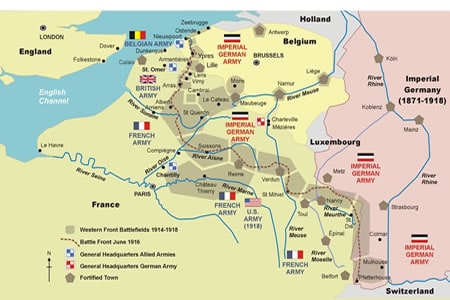
During The Great War of 1914-1918, the Allied Forces of Belgium, France, Great Britain, Portugal and the United States (from April 1918) made a stand against the Imperial German Army’s advance and occupation of Belgium from the 4th of August 1914 and north-eastern France from the 6th of August 1914.
The outcome of the battles resulted in the formation of a battlefront, which saw three years of attrition warfare in 1915, 1916 and 1917, with only a few months of mobile warfare at the start and at the end of four years of fighting.
The British Expeditionary Force, fighting on the battlefields in Belgium and France for four years, named this battle front in France as ‘The Western Front‘.
You can find out more about the action behind each battle during this campaign by clicking on the appropriate link on the left-hand side of the timeline.
Arrival in France – 1914
The 3rd Hussars sailed from Southampton on the 14th of August to Le Havre, and then up the Seine to Rouen on the 17th of August 1914, where they joined a Composite Regiment of the Household Cavalry and the 6th Dragoon Guards, their companions in the 4th Cavalry Brigade, part of the 1st Cavalry Division.
On the outbreak of the Great War, the 4th Hussars were stationed at the Curragh, Ireland. It embarked on the 15th August 1914 at Dublin, under the Command of Lieutenant Colonel I.G Hogg DSO and disembarked at Le Havre, France on the 18th August. The regiment belonged to the 3rd Cavalry Brigade which also included the 5th and 16th Lancers, part of the 1st Cavalry Division.
When the First World War began in 1914, the 8th Hussars were stationed at Ambala, 125 miles north of Delhi in India. They were mobilized on the 31 August and left India at Bombay in two halves in October 1914. The 8th Hussars served as part of the Ambala Cavalry Brigade, 1st Indian Cavalry Division and arrived at Marseilles, France in November 1914. The 8th spent the early years in reserve in case a big cavalry push was required. Much of their time was spent in digging trenches. In March 1918 when the Indian regiments left for Egypt, they joined the 15th and 19th Hussars as part of the 9th Cavalry (Hussar) Brigade.
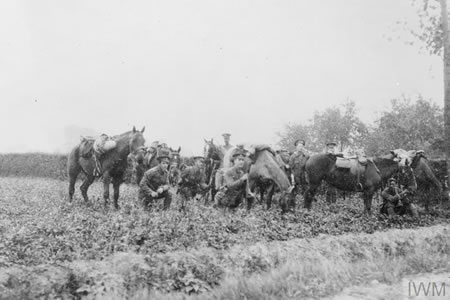
Mons – 22 Aug 1914
This was the first encounter between British and German forces on the Western Front. The British Expeditionary Force (B.E.F.) comprised four infantry divisions and one cavalry division of the British First Army, which had landed at the French coast from 16 August.
The B.E.F. had advanced through northern France and Belgium to move in on the French Fifth Army’s left flank on the Sambre river. Having reached the area of Mons on the 22nd of August the B.E.F. encountered German patrols at Soignies, which were advancing ahead of the German First Army.
The next day, the 23rd of August, the German First Army launched an attack at a strength of over two to one against four British divisions with a cavalry division in reserve. The British managed to hold up the Germans inflicting heavy casualties by the superior rifle fire from the highly trained British soldiers. With the realization that the small British force was up against a much greater force in terms of German manpower and artillery, the British ordered a retreat from Mons.
With orders to maintain contact with the French forces also retreating on their right flank, the British found themselves fighting a rearguard action during their withdrawal and fought the Battle of Le Cateau on the 26th of August.
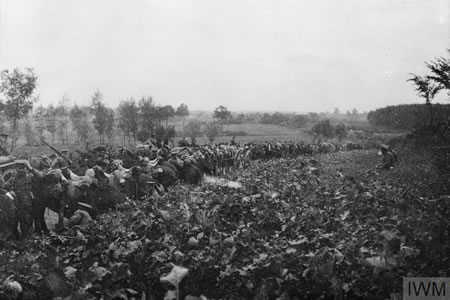
First Battle of the Marne – 6-22 Sep 1914
By the 3rd of September the British Expeditionary Force had crossed the Marne river in a retreat to the south and was in a position east of Paris between the French Sixth and French Fifth Armies. From the 5th to the 8th of September the French Armies and British First Army carried out counter-attacks against the German advance. On the 9th of September the German First Army began to pull back as the British First Army moved in on its left flank.
With no option but to make a fighting withdrawal, all the German forces in the Marne river region retreated in a northerly direction, crossing the Aisne to the high ground of the Chemin des Dames ridge.
The First Battle of the Marne was a strategic victory for the Allied Forces. It marked a decisive turn of events for the Allies in the early weeks of the war.
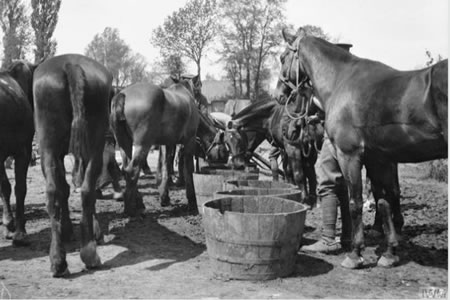
First Battle of the Aisne – 12-28 Sep 1914
From the 12th of September 1914 the German Army began to ‘dig in’ on the high ground of the Chemin des Dames ridge on the north bank of the river Aisne.
The Germans dug defensive trenches with the intention of securing the position and preventing any further possibility of withdrawal. This battlefield area witnessed the beginnings of entrenched positions and the change from a mobile war to a static deadlock between the opposing forces. During the battle the German right wing could not be dislodged by the Allied forces of the French Sixth Army, the British Expeditionary Force and the French Fifth Army.
The consequence of the Germans establishing entrenched positions on the Chemin des Dames ridge was that the Allied armies were unsuccessful in making a frontal assault on it.
Approximately 3,000 British soldiers died during the attack.
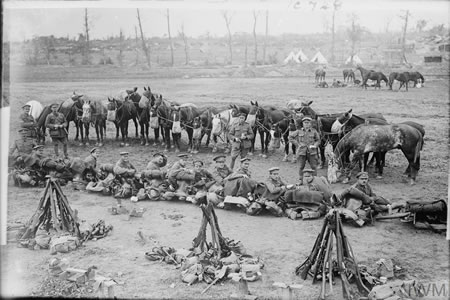
The ‘Race to the Sea’ – 25 Sep – 22 Nov 1914
Now began the long, flanking march by the British Army which was destined to end at Ypres.
Over the next few weeks from late September to the end of November 1914 the Allied and German Armies attempted to outflank one another, responding to each other maneuvering their armies to make a stand or cover their exposed northern flank.
Operationally it was not an intentional race to reach the French or Belgian coast before the other.
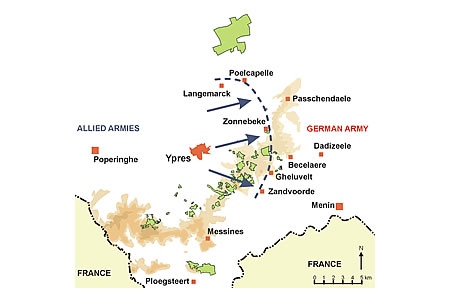
First Battle of Ypres – 19 Oct – 22 Nov 1914
This battle occurred in the late autumn at a crucial point in the ‘Race to the Sea’, when the Allied Armies and the German Armies were engaged in an attempt to outflank one another in a desire to reach and secure the ports on the northern French coast. With the agreement of the French Commander-in-Chief (General Joffre), the British Commander-in-Chief (Field-Marshal Sir John French) withdrew British forces of the British Expeditionary Force (B.E.F.) from their positions on the Aisne battlefield.
The four new German Corps of the German Fourth Army made an advance on the British Line north east of Ypres. German casualties were very heavy especially in the vicinity of Becelaere and Langemarck.
On the 29th of October the German Army attacked the British Line on the Menin Road at Kruisecke Crossroads, east of Gheluvelt. The German aim was to break through the British front and take Ypres.
On the 31st of October the British line is broken but a successful counter-attack recaptured the village and restored the break in the British Front Line.
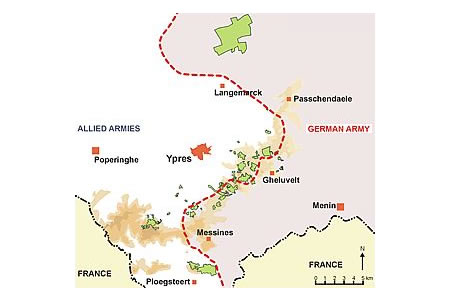
Second Battle of Ypres – 22 Apr – 25 May 1915
The Second Battle of Ypres started on a warm spring afternoon with the trial of a new weapon of war in the Ypres sector: a cloud of poisonous gas.
After two attempts to release the gas earlier in the month, this was a cloud of chlorine gas released by the German Fourth Army, followed by an infantry attack. The gas cloud was blown on a gentle breeze across two French divisions in the north part of the Ypres Salient.
The German infantry advance behind the cloud was rapid, the Allied Front Line was broken and the way to Ypres was open by the end of the day.
The battle for the defence of Ypres and the recapture of lost ground included more German gas cloud attacks against the Allied troops.
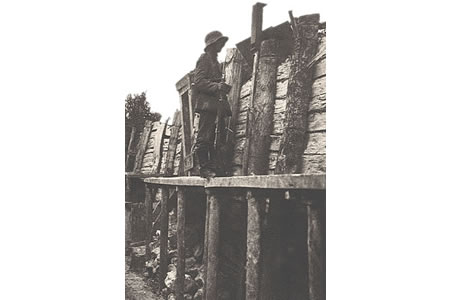
Battle of the Somme – 1 Jul – 18 Nov 1916
The 1916 Battle of the Somme was an Allied offensive carried out jointly by the British Army and the French Army in the sector of the Western Front north and south of the river Somme.
The battle began in the early morning of 1 July after an artillery bombardment lasting several days, and such as had never been witnessed on the Western Front or any other battlefield before.
The first day of the battle claimed over 58,000 British casualties of whom more than 19,000 were killed. This was the largest loss on a single day in the history of the British Army.
Over a period of four and a half months the battle continued in several phases, with the British Army making limited advances by capturing key villages and ridges, but advancing only a few miles by the close of the battle and the wintry weather in November.
The Battle of the Somme in 1916 witnessed the first use of tanks in combat at the Battle of Flers-Courcelette.
Villers-Faucon
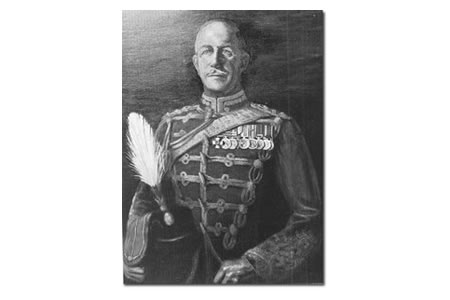
The Action at Villers-Faucon – 27 Mar 1917
The last mounted cavalry charge took place at Villiers-Faucon in 1917.
‘D’ Squadron of the 8th Hussars charged and captured a village.
The squadron was commanded by Major Van der Byl who later became Colonel of the regiment.
The two machine guns taken from the Germans remained as regimental trophies.
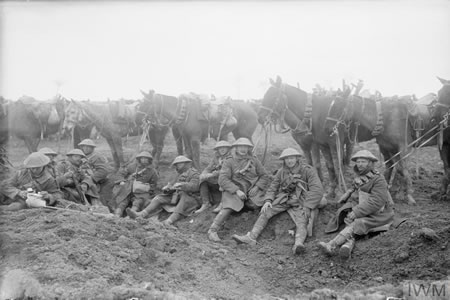
Battle of Arras – 9 Apr – 4 May 1917
The British Expeditionary Force was to carry out diversionary attacks as part of an Artois offensive at Arras. Some disruption to the battle planning was caused by the German withdrawal to the Hindenburg Line between Arras and Soissons, but also reservations were expressed by the French government about Nivelle’s optimistic forecast of a surprise attack and a victory for the offensive. A vote of confidence in Nivelle’s plan resulted in the collapse of the French governement.
The British attacks began a week before the French Nivelle offensive.
The British attacks achieved some limited success, but the French offensive further south was a failure with 187,000 casualties. Mutiny in the French units became widespread and morale was very low.
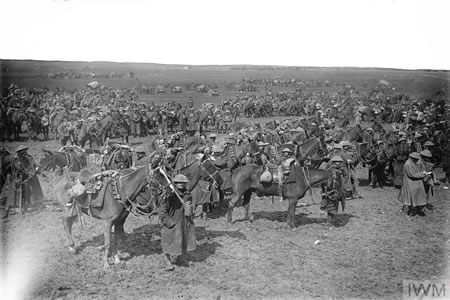
First Allied Mass Tank Attack – 20 Nov – 7 Dec 1917
The first use of the new tank weapon in a large-scale attack was launched at the Battle of Cambrai with over 450 tanks against the German Front Line at the Cambrai salient.
There was no preliminary bombardment before the attack and the assault on the German lines was a surprise. The Germans lost ground on the first day of the battle.
Fighting continued over the next few days and on the 30th of November a German counter-attack of 20 divisions began to push the British back across the ground they had captured.
By the 7th of December the battle had ended and the British had lost almost all the ground taken in the first few days of the attack.
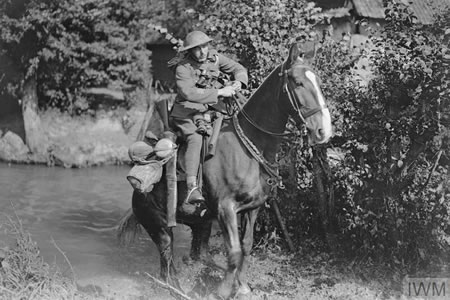
‘Kaiserschlacht’ – the German Michael Offensive – 21 Mar – 5 Apr 1918
Known to the German Army commanders as the “Kaiserschlacht” (Kaiser’s Battle). Under the code name of ‘Operation Michael’ the first German offensive of 1918 was launched against the British Front Line on the foggy morning of 21 March between Cambrai, St. Quentin and La Fère on the Somme battlefield.
The aim of this offensive was to push the British westwards and drive a wedge along the boundary of the British and French Armies at La Fère.
A massive artillery bombardment preceded the surprise attack on 21 March. The German assault was made against the British-held Front Line for a distance of 50 miles. The defenders of the British Third and Fifth Armies were up against a superiority in troop numbers of three to one; 26 British divisions were up against 62 German divisions, with an accompanying strength of 6,600 German artillery pieces compared to 2,600 British guns. The attack divisions were trained in the techniques of aggressive assault as storm troopers and there had been training in the co-ordination of command between the infantry and artillery.
The German advance made significant gains on the first day in the British Fifth Army sector. North of the Somme river the British Third Army blocked the German advance on 26 April.
Under the code name ‘Operation Mars’ the Germans attacked the southern Arras sector but it was not successful. South of the Somme river the German advance did continue to within 10 miles of the Allied rail centre of Amiens. The Allies halted the Germans in a stand at the village of Villers-Bretonneux.
Despite the large amount of Allied ground captured in the first few days of the offensive, the German advance faltered because the troops became exhausted, there was difficulty keeping the troops at the front of the advance supplied with food and equipment by having to cover long distances over destroyed ground.
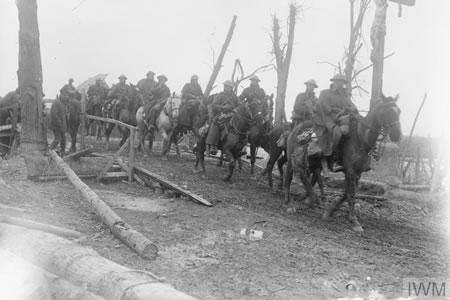
The German Lys Offensive – 9-29 Apr 1918
As the weather conditions began to improve after the winter, a second phase of the offensive, codenamed Operation Georgette in the German plan was the start of the Battle of the Lys. The offensive was launched against the Allied line in the low-lying, British-held sector on both sides of the Lys river in French Flanders. The German objective was the important Allied rail centre of Hazebrouck.
On the first day the German Sixth Army attack was launched against two divisions of the Portuguese Army, holding the Allied Front Line between La Bassée and Armentières.
The Portuguese could not withstand the force of the attack and the Germans captured almost four miles of ground. On the following day, 10th April, the German Fourth Army made an attack a little further to the north against the British Second Army holding the Front Line in Belgian Flanders.
The British were pushed back beyond the villages of Messines and Wyteschaete. The situation for the British was very serious by 12 April, which compelled them to make decisions about making tactical withdrawals to positions which could be more easily defended.
The German attacks continued against the British line and also against the Belgian Army holding the line north of Ypres but no ground was gained. French reinforcements arrived to support the British defence on the high ground of Mount Kemmel. The Germans attacked these newly arrived French troops on 25 April.
By 29 April the German offensive had been blocked and no further attacks were made. The Germans had not captured any of their objectives as the Allies had held onto Hazebrouck and the Channel ports.
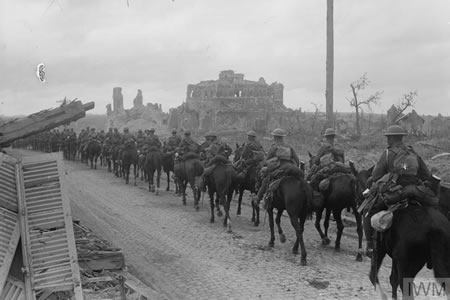
The Battle of Amiens – 8-11 Aug 1918
The Allied offensive of the summer opened with the Battle of Amiens on 8 August. The Allied forces surprised the Germans on the 8th of August and made rapid progress eastwards of several miles, taking hundreds of German prisoners on the way.
This battle marked the end of the stalemate of trench warfare on the Western Front, the effective combination of infantry, air support and tanks.
It was the beginning of several battles from August to November 1918, which became known as the Hundred Days Offensive.
The Allied success of the 8th of August was a black day for the German Army.
Albert
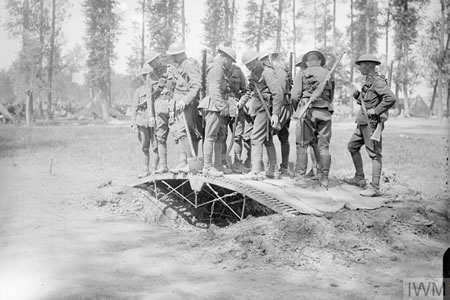
The Battle of Albert – 21-22 Aug 1918
The British Third Army and the United States II Corps launched the attack to recapture Albert on the 21st of August.
The town of Albert was retaken on 22nd and the town of Bapaume was captured on the 29th of August.
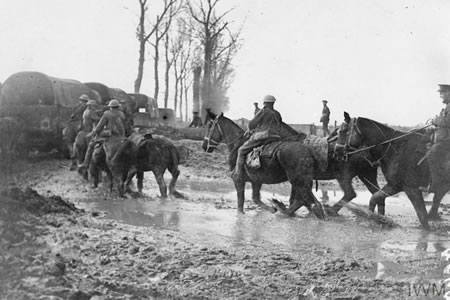
Breaking Through the Hindenburg Line – 12 Sep – 9 Oct 1918
The Battle of Havrincourt was launched on the 12th of September as a successful attack by the British Third Army with three divisions against four German Army divisions holding the fortified town of Havrincourt.
The Battle of Epéhy on the 18th of September was launched against a 20 mile section of outpost positions for the Hindenburg Line. Following the success at Havrincourt, three corps of the British Fourth Army, one corps of the British Third Army and units of the French First Army. The left and right wings of the advance progressed with difficulty, but the two Australian divisions in the centre of the advance were successful in achieving an advance of three miles.
The success of this attack showed to the Allies that the German defence, even on the fortified Hindenburg Line positions, was not impossible to break through.
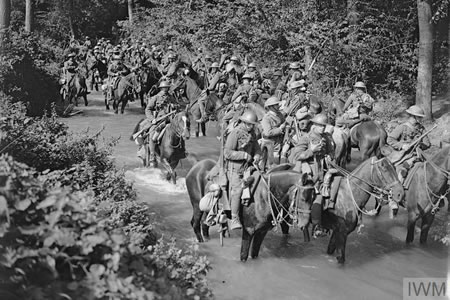
The Battle of Canal du Nord – 27 Sep – 1 Oct 1918
The Battle of Canal du Nord took place against a section of the canal and the outskirts of Cambrai.
The British First Army was to cross the canal continuing the advance following on from the Battle of the Drocourt-Quéant Line and advance towards Cambrai.

The Battle of the St. Quentin Canal – 29 Sep – 2 Oct 1918
This attack was launched on th 29th September by US, French and British forces. A north-south stretch of this canal between St. Quentin and Vendhuille had been incorporated into the German defences of the Hindenburg Line.
The German defences on the canal comprised not only barbed wire entanglements and traps, but generally this stretch of canal was in a deep cutting of about 50 to 80 metres.
The canal ran through a tunnel at Bellicourt and there was a bridge further south of the tunnel at Bellenglise.
The British Fourth Army and the French First Army had reached the canal sector in mid September, and were tasked with crossing the canal at the tunnel section or by the bridge. An attempt by a US regiment to clear the German strongpoints at Bellicourt in advance of the main attack did not succeed, and the attack by US and Australian troops on 29th September did not make progress through the Hindenburg Line at Bellicourt.
However, an attack by the British IX Corps at Bellenglise did succeed in crossing the bridge with two divisions before the Germans could blow it up.
With reinforcements brought down from Bellicourt following across the bridge, the Allied crossing of the canal advanced about 6 miles beyond the canal by the end of the day.
Over 5,000 German prisoners were captured.
St Quentin Canal
Cambrai
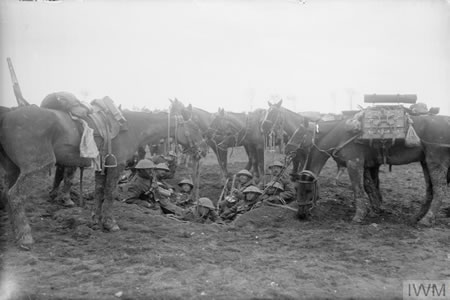
The Second Battle of Cambrai – 8-10 Oct 1918
This was a successful offensive by the British First, Third and Fourth Armies with the support of tanks.
The advance crossed three German lines of defence which were lightly manned, took Cambrai within two days and suffered very light casualties.
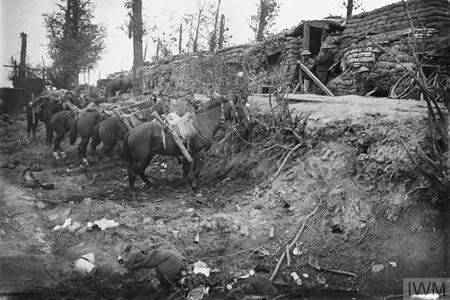
The Battle of the Selle – 17-26 Oct 1918
This took place as the Allies continued the advance after the Second Battle of Cambrai, recapturing French villages one by one as the German forces retreated to the north-east.
Selle
Sambre
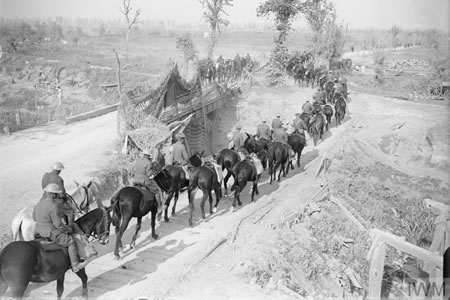
The Battle of the Sambre – 4 Nov 1918
This was a continuation of the Allied advance by Haig’s Army Group (the First, Third and Fourth Armies and the French First Army) coming from the direction of Valenciennes.
The Allied troops were to advance from the Condé Canal on a thirty mile front towards Maubeuge-Mons.

